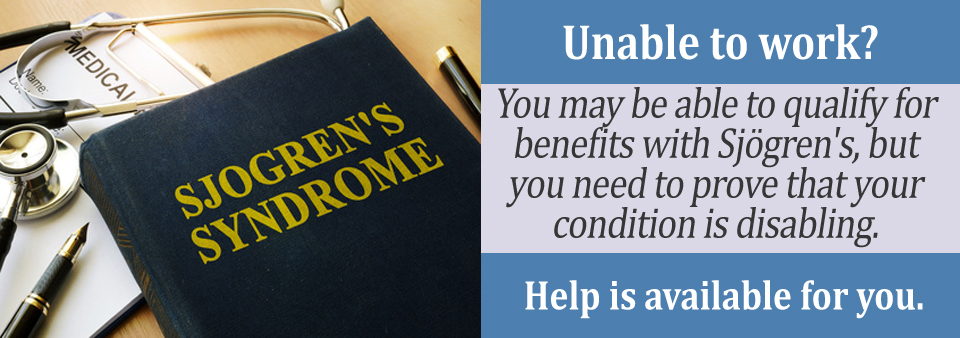Sjögren’s syndrome, an autoimmune disease in which white blood cells attack tear and saliva glands, has gained recognition as a debilitating illness over the last several years.
While Sjögren’s syndrome initially causes dry eyes and mouth, it can also progress to cause fatigue and wreak havoc on various organs of the body. Severe cases of Sjögren’s may qualify for Social Security Disability Insurance Program (SSDI) disability benefits.
Not all individuals who are diagnosed with Sjögren’s syndrome will be awarded financial assistance from the Social Security Administration (SSA).
Only those individuals who can offer compelling medical evidence to match the severity of their Sjögren’s syndrome will be considered for disability benefits.
Can You Get Disability Benefits For Sjögren’s Syndrome?
Those with Sjögren’s syndrome can get disability benefits. If you have Sjögren’s Syndrome you can qualify for disability benefits if:
- There is involvement of two or more organs/body systems with:
- One of the organs/body systems involved to at least a moderate level of severity; and
- At least two of the constitutional symptoms or signs (like a fever, involuntary weight loss, malaise or severe fever)
OR
- Repeated manifestations of Sjögren’s syndrome, with at least two to the constitutional symptoms or signs (involuntary weight loss, malaise, severe fatigue, or fever) and one of the following at the marked level:
- Limitation of activities of daily living.
- Limitation in maintaining social functioning.
- Limitation in completing tasks in a timely manner due to deficiencies in concentration, page or persistence.
When trying to prove that your Sjögren’s syndrome meets this criteria, you will need to use the Blue Book as a guide.
The Importance of the “Blue Book” When You Have Sjögren’s Syndrome
Up until recently, those diagnosed with Sjögren’s syndrome would have to match another related autoimmune illness in the Blue Book. The Blue Book is the list of conditions that qualify for disability.
This medical guide serves as a reference for administrators in determining what conditions qualify as disabilities and what specific criteria and symptoms are needed to be approved.
In 2008, Sjögren’s syndrome was officially added to the Blue Book under section 14.10. Now, those with Sjögren’s syndrome can meet a listing specific to their illness.
“Meeting a listing” is the easiest way to earn Social Security disability benefits.
To help you with the information-gathering process, here is the most relevant medical evidence that you will need to provide related to your Sjögren’s syndrome that will give you the best chance of being approved for SSDI.
Considering applying for Social Security disability benefits with Sjögren's syndrome but not sure how much you’ll earn per month? Our Social Security Benefits Calculator can help you determine how much you’ll receive from the SSA before you file for disability.
Evidence Needed Related to Your Sjögren’s Syndrome Diagnosis
The first type of medical evidence that the Blue Book directly requests is a complete medical history of your Sjogren’s syndrome. You should be able to provide evidence of your Sjögren’s syndrome, which includes physical examination and diagnostic tests. Physical examination notes should discuss any of the following symptoms that may be present for you:
- Dry eyes or dry mouth
- Eye damage such as corneal abrasions or eyelid inflammation
- Trouble swallowing
- Excessive cavities
- Any difficulty with speaking
- Persistent dry cough
- Severe fatigue or malaise
- Fevers
- Involuntary weight loss
- Any related problems with other body systems.
Several tests will help to confirm your diagnosis, and the following should be included in your records:
- Blood antibody tests: Typical antibodies for Sjögren’s syndrome may include anti-nuclear antibodies (ANA), rheumatoid factor (RF), SS-A (Ro) and SS-B (La).
- Additional blood tests: Erythrocyte sedimentation rate (ESR) and Immunoglobulins (IG) may also be tested. Additionally, a liver and kidney panel may be done to determine if there are related problems with your organs.
- Ophthalmologic (Eye) Tests: This includes the Rose Bengal or Lissamine Green test and the Schirmer test
- Dental Imaging Tests: Includes Sialogram and Salivary Scintigraphy
- Lip (or salivary gland) Biopsy: A positive lip biopsy is considered the “gold standard” for diagnosis of Sjogren’s syndrome.
Most patients with Sjögren’s syndrome will work with a rheumatologist. Be sure that your rheumatologist has documented all of the relevant information as documented above.

Evidence Needed Related to Body Systems Affected By Sjögren’s Syndrome
Sjogren’s syndrome often impacts many other organ systems. Commonly associated body systems and associated symptoms may include, but are not limited to:
- Musculoskeletal: Arthritis, muscle inflammation
- Respiratory: Lung diseases including pulmonary fibrosis
- Gastrointestinal Difficulty: swallowing, difficulty digesting food, involuntary weight loss
- Genitourinary: Bladder spasms, kidney disorders
- Skin: Bruising, inflammation of veins
- Neurologic: Nerve damage in the brain and body, dizziness, imbalance
- Mental: Poor memory, difficulty with processing information
- Neoplastic: Lymphoma
- Other autoimmune disorders such as rheumatoid arthritis or lupus
If you have experienced any of the above, be certain that your physician carefully documents your Sjögren’s syndrome ailments.
The Blue Book indicates that you must have one of the organ/body systems involved to a moderate level of severity AND at least two of the following constitutional symptoms: severe fatigue, fever, malaise, or involuntary weight loss.
Evidence Needed Related to Your Sjogren’s Treatments
The majority of patients with Sjögren’s syndrome remain relatively healthy and are able to function in their lives.

However, some patients with Sjögren’s syndrome experience many debilitating symptoms.
The treatment for Sjögren’s syndrome will depend on the severity of the illness, and will mostly be aimed at controlling the symptoms.
The SSA will need to know what treatments you have received for Sjögren’s syndrome, your response to those treatments, and most importantly if your health status has worsened despite those treatments.
Be sure that your doctor has documented the following:
- Medications that you are receiving, such as corticosteroids, immunosuppressants, pain medications, or any other related medications
- The dose and frequency of your medications
- Any treatments or lifestyle modifications that you have been required to make, such as using eye drops, using saliva substitutes, etc.
- Any surgeries or procedures that you may have had, including operative notes or pathology reports, if applicable
- Any related medical complications, such as weakness, neurological complications, heart problems, or intellectual difficulties
Not every patient who has Sjögren’s syndrome will meet the listing as outlined in the Blue Book. However, you still might be unable to hold out substantial gainful employment. It is essential that you provide adequate medical documentation about your treatments, medications, and side effects to the SSA to qualify with Sjögren's syndrome.
Medical evidence will work in your favor to convince the SSA that you are too ill to work, and that your Sjögren’s syndrome is expected to last for at least one year.
Evidence Needed Related to Your Quality of Life and Ability to Care for Yourself With Sjögren’s Syndrome
The Blue Book indicates that people with Sjögren’s syndrome may qualify for benefits if they experience constitutional symptoms along one of the following:
- Limitations of activities of daily living (ADLs): This may include, but is not limited to, performing household chores, personal hygiene, taking public transportation, or paying bills.
- Limitation in maintaining social functioning: This may include communicating appropriately with others, managing sustained relationships, and interacting independently with others.
- Deficiencies in concentration, persistence, or pace: This may include finishing projects on time, keeping up a reasonable pace at work, and the ability to work without excessive breaks.
If you have difficulty with any of the above due to symptoms related to your Sjögren’s syndrome such as pain, severe fatigue, anxiety, or a pattern of exacerbation and remission caused by Sjögren’s syndrome OR its treatment, be certain that your rheumatologist documents those difficulties carefully.
Your rheumatologist should provide physician notes documenting his or her opinion regarding your limitations and inability to function without unscheduled breaks or days off. You can even request a disability doctor letter of support.
For example, if you have difficulty talking as a result of your Sjögren’s syndrome, it may cause your job to be very challenging.
Be sure that your doctor documents any limitations that you might have with Sjögren's syndrome, no matter how small they seem.
Steps You Can Take to Win Your Disability Claim With Sjögren’s Syndrome
It can be difficult to think about an application process when you are unwell. Keep in mind that your ability to provide medical evidence listed in the Blue Book is the most crucial factor in winning your Social Security disability claim for Sjögren’s.
The first thing that you will want to do is to meet with your rheumatologist to review section 14.10 of the Blue Book together.
You should determine if you meet the listing, what medical records you have on hand, and what documentation is still needed to be approved for disability with Sjögren’s syndrome. You may need to seek medical records from your various health practitioners.
There are several ways your rheumatologist can help, including:
- Ensuring that your full medical history related to your Sjogren’s syndrome is up to date
- Listing your past treatments and responses, as well as the plan for the future
- Documenting all of your medications and experienced side effects
- Performing any additional blood tests or procedures that you are missing
Social Security disability advocates and attorneys are experts at the SSDI claims process. Not only can one assist you with your application and the information-gathering process, but an advocate or attorney can work with the SSA on your behalf in order to qualify with Sjögren's syndrome.
Evaluations are free, and disability attorneys and disability advocate only get paid you win your Sjögren’s syndrome claim.